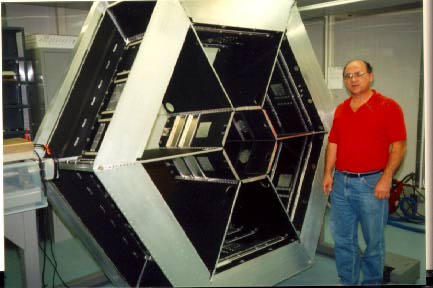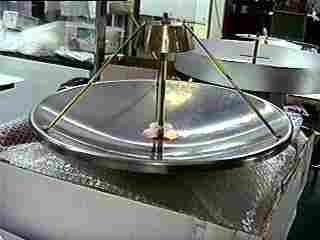Phase 3D
AMSAT
OSCAR 40
Official
Transponder Frequency Bandplan
After several
iterations and as a result of intensive research
and discussions with all involved transponder
builders, the P3-D Project Manager Dr. Karl
Meinzer, DJ4ZC gave his final OK to the P3-D
Transponder frequencies.
They have been carefully selected to minimize
mutual interferences with other satellite
projects and are also coordinated with IARU
bandplans by the P3-D Frequency Coordinator,
Freddy de Guchteneire, ON6UG, with the help of
Peter Guelzow, DB2OS and Werner Haas DJ5KQ.
P3-D
Uplink Frequencies
| UPLINK |
Digital |
Analog Passband |
| 15 m |
none |
21.210 - 21.250
MHz |
| 12m |
none |
24.920-24.960 MHz |
| 2 m |
145.800 - 145.840
MHz |
145.840 - 145.990
MHz |
| 70cm |
435.300 - 435.550
MHz |
435.550 - 435.800
MHz |
| 23cm(1) |
1269.000 - 1269.250
MHz |
1269.250 - 1269.500
MHz |
| 23cm(2) |
1268.075 - 1268.325
MHz |
1268.325 - 1268.575
MHz |
| 13cm(1) |
2400.100 - 2400.350
MHz |
2400.350 - 2400.600
MHz |
| 13cm(2) |
2446.200 - 2446.450
MHz |
2446.450 - 2446.700
MHz |
| 6cm |
5668.300 - 5668.550
MHz |
5668.550 - 5668.800
MHz |
P3-D Downlink Frequencies
| DOWNLINK |
Digital |
Analog Passband |
| 2m |
145.955 - 145.990
MHz |
145.805 - 145.955
MHz |
| 70cm |
435.900 - 436.200
MHz |
435.475 - 435.725
MHz |
| 13cm(1) |
2400.650 - 2400.950
MHz |
2400.225 - 2400.475
MHz |
| 13cm(2) |
2401.650 - 2401.950
MHz |
2401.225 - 2401.475
MHz |
| 3cm |
10451.450 -
10451.750 MHz |
10451.025 -
10451.275 MHz |
| 1.5cm |
24048.450 -
24048.750 MHz |
24048.025 -
24048.275 MHz |
P3-D Telemetry Beacons (IHU)
| BEACON |
General Beacon
(GB) |
Middle Beacon
(MB) |
Engineering
Beacon (EB) |
| 2 m |
none |
145.898 MHz |
none |
| 70cm |
435.438 MHz |
435.588 MHz |
435.838 MHz |
| 13cm(1) |
2400.188 MHz |
2400.338 MHz |
2400.588 MHz |
| 13cm(2) |
2401.173 MHz |
2401.323 MHz |
2401.573 MHz |
| 3cm |
10450.975 MHz |
10451.125 MHz |
10451.375 MHz |
| 1.5cm |
24047.885 MHz |
24048.035 MHz |
24048.285 MHz |
Beacon Frequencies have been
measured before launch at Kourou and may change
due to
aging, vibrations or temperature. 2-m-MB and
13-cm(2)-MB have already been measured in orbit.
Remarks:
- All Receivers are
inverting!
- Telemetry Beacons are for
command purposes and are modulated in 400
Bit/s BPSK, AMSAT format.
- The MB can be switched
between IHU-1 or IHU-2 telemetry.

Phase
3D - AMSAT OSCAR 40
AO-40:
X-band report
Stacey W4SM and Michael OH2AUE tested
the X-band transmitters (solid state and TWT)
yesterday (2001-05-13) between 04:11 UTC and and
06:00 UTC.
Unfortunately the test was not successful. The
IHU-1 telemetry indicates the proper commands,
but indications are that no power is getting to
any of the X-band modules. Nothing happened... In
fact, even the status of the
temperature sensors in the X-band modules did not
change. These sensor are not thermistors like the
rest and need power supply to give valid
readings. The values did not changed when the
module was commanded on, thus there is no
electrical power within the module. The problem
must be either in the 28V-S supply or in the
module power control line from the IHU. Such a
problem was never observed during all the testing
in Orlando and Kourou. A
software problem is very unlikely. However, it is
planned to investigate this further in the next
few days and another attempt will be made soon.
LEILA,
RUDAK, X, C and more...
History was made on Saturday (May 12th) when the
LEILA system on AO-40 was turned on for the first
time! This morning a couple of *very* strong
signals
appeared in the passband, several dB louder than
the MB!!! Several people tried to get them to
reduce power, but they apparently weren't
listening. The AGC on the U-band Rx was
suppressing up to 16 dB, clearly in sync with
their transmissions and there was massive
grumbling on the passband.... Remember that the
MB is 8dB louder than the GB and users should not
be stronger than the GB. So, it was decided that
this might be a good chance to test LEILA. LEILA
was switched into the U-band passband, which can
be seen by the
MATRIX configuration. LEILA was configured for
SCAN/JAM/NOTCH mode and it worked like a charm!!
The threshold was set to a level which was
approximately equal to the GB signal, which means
any stronger signal will be detected by LEILA..
an "police siren" will be heard to give
a chance to reduce power, otherwise the notch
will do it's best... :) People on the passband
loved it! This is indeed another major success
within a few weeks for AO-40 and in particular
for the
LEILA concept (LEIstungs Limit Anzeige), which
was designed by AMSAT-DL (Dr. Karl Meinzer DJ4ZC
and Matjaz Vidmar S53MV)and also supported by the
german ministry of science and technology.
Indeed, it is the first time that such a system
is used in space for a transponder with
uncoordinated multiple access.
If everything goes well, we will probably leave
LEILA continuously in the loop..
Meanwhile the RUDAK team did also good progress
and both CPU's are running now for more than 10
days. In a 6 hour effort on friday morning Jim
White WD0E finished loading the GPS task into
RUDAK-A and loaded the
CEDEX task. Both tasks are running but commands
to begin their operations were not yet sent. This
is planned for saturday or sunday, when data from
CEDEX will be logged and possibly a GPS lock
sequence will be initiated.
Jim also reported that RUDAK-A TLM continues to
look normal and also the
SmartNode temperature sensors on the CAN bus seem
to work fine. Both 153.6 KBit/s highspeed PSK
downlinks were also verifi edand they came on as
expected and were turned off again later. While
at zero Doppler the
downlink frequencies of the 9k6 hardware
modulators through S1 are:
RUD A mod 0 = 2400.791
RUD A mod 1 = 2400.765
RUD B mod 0 = 2400.910
RUD B mod 1 = 2400.891
(measured with an accuracy of +-5 KHz)
And finally... X-band and possibly C-band testing
this morning!!!
73s Peter DB2OS
for the whole AO-40 team
AO-40 Equipement

Phase
3D - 10 GHz dish
|
